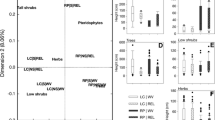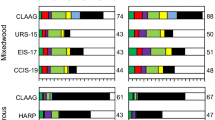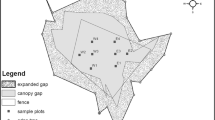Abstract
Successful regeneration of northern red oak (Quercus rubra L.) on productive sites is problematic in eastern North American forests. Natural and artificial regeneration often cannot compete with fast-growing, shade intolerant species such as yellow-poplar (Liriodendron tulipifera L.). This study examines 5-year survival, growth, and competitive ability of planted northern red oak seedlings in various group selection harvest sizes in south-central Indiana, USA. Seedling stocktypes consisted of high (BHD; 75 seedlings m−2) and low (BLD; 21 seedlings m−2) nursery-bed-density bareroot seedlings, and small (CS; 11.4 L) and large (CL; 18.9 L) container seedlings. Group selection openings included large (0.400 ha), medium (0.100 ha), and small (0.024 ha) circular gaps in four stands. Larger stocktypes and gap sizes improved seedling height, diameter, and growth; ANOVA indicated only gap size was significant for seedling survival. Logistic regression showed survival was positively correlated to diameter at year 1, and aspect, gap size, and stocktype were significant predictors of survival. Our data indicated no differences in density of natural regeneration among gap sizes, although trends suggest greater numbers of bigger competitors in larger gaps sizes. Yellow-poplar regeneration was the tallest competitor of more than 50% of all northern red oak seedlings. Competitive status of seedlings after 5 years differed only by stocktype, with large container stock in a better competitive position than bareroot stock. However, less than 20% of seedlings in all stocktypes in each gap treatment were considered competitive (i.e., ≥80% of the height of tallest competitor) against their tallest competitor. The use of larger planting stock may offer greater opportunities for successfully regenerating northern red oak seedlings on productive sites but likely would have to be accompanied by treatments to reduce woody competition.






Similar content being viewed by others
References
Beck DE, Hooper RM (1986) Development of a southern Appalachian hardwood stand after clearcutting. South J Appl For 10:168–172
Beers TW, Dress PE, Wenzel LC (1966) Aspect transformation in site productivity research. J For 64:691–692
Birge ZKD, Salifu KD, Jacobs DF (2006) Modified exponential nitrogen loading to promote morphological quality and nutrient storage of bareroot-cultured Quercus rubra and Quercus alba seedlings. Scand J For Res 21:306–316
Bradshaw FJ (1992) Quantifying edge effect and patch size for multiple-use silviculture—a discussion paper. For Ecol Manag 48:249–264
Burdett AN, Herring LJ, Thompson CF (1984) Early growth of planted spruce. Can J For Res 14:644–651
Clark FB (1993) An historical perspective of oak regeneration. In: Loftis DL, McGee CE (eds) Oak regeneration: serious problems practical recommendations, Gen Tech Rep SE-84, USDA Forest Service, Southeastern Forest Experiment Station, Asheville, NC, pp 3–13
Davis AS, Jacobs DF (2004) First-year survival of northern red oak seedlings planted on former surface coal mines in Indiana. In: Barnhisel RI (ed) Proceedings of a joint conference of American society of mining and reclamation 21st annual national conference and 25th West Virginia surface mine drainage task force symposium, Lexington, KY, pp 480–502
Dey DC, Parker WC (1997) Morphological indicators of stock quality and field performance of red oak (Quercus rubra L.) seedlings underplanted in a central Ontario shelterwood. New For 14:145–156
Dey DC, Kabrick JM, Gold MA (2003) Tree establishment in floodplain agroforestry practices. In: Sharrow SH (ed) Proceedings of AFTA 2003: the 8th North American agroforestry conference, Association for Temperate Agroforestry, Corvallis, OR, pp 102–115
Dey DC, Jacobs D, McNabb K, Miller G, Baldwin V, Foster G (2008) Artificial regeneration of major oak (Quercus) species in the eastern United States—a review of the literature. For Sci 54:77–106
Gottschalk KW (1987) Effects of shading on growth and development of northern red oak, black oak, black cherry, and red maple seedlings. II: Biomass partitioning and prediction. In: Hay RL, Woods FW, DeSelm H (eds) Proc of 6th Central hardwood forest conference. Univ. of Tennessee, Knoxville, pp 99–110
Gottschalk KW (1994) Shade, leaf growth and crown development of Quercus rubra, Quercus velutina, Prunus serotina and Acer rubrum seedlings. Tree Physiol 14:735–749
Groninger JW, Long MA (2008) Oak ecosystem management considerations for central hardwoods stands arising from silvicultural clearcutting. North J Appl For 25:173–179
Hanson PJ, Isebrands JG, Dickson RE (1987) Carbon budgets of Quercus rubra L. seedlings at selected stages of growth: influence of light. In: Hay RL, Woods FW, DeSelm H (eds) Proc of 6th Central hardwood forest conference. Univ. of Tennessee, Knoxville, pp 269–276
Hosmer D, Lemeshow S (2000) Applied logistic regression, 2nd edn. Wiley, New York
Jacobs DF (2003) Nursery production of hardwood seedlings. FNR-212. Purdue University Cooperative Extension Service, West Lafayette, IN, p 8
Jacobs DF, Seifert JR (2004) Re-evaluating the significance of the first-order lateral root grading criterion for hardwood seedlings. In: Yaussy D, Hix DM, Goebel PC, Long RP (eds) Proc of 14th Central hardwood forest conference. Gen Tech Rep NE-316, USDA Forest Service, North Central Research Station, St. Paul, MN, pp 382–388
Jacobs DF, Ross-Davis A, Davis AS (2004) Establishment success of conservation tree plantations in relation to silvicultural practices in Indiana, USA. New For 28:23–36
Jacobs DF, Salifu KF, Seifert JR (2005) Relative contribution of initial root and shoot morphology in predicting field performance of hardwood seedlings. New For 30:235–251
Jacobs DF, Rathfon RA, Davis AS, Carlson DE (2006) Stocktype and harvest gap size influence northern red oak regeneration success. US For Serv Gen Tech Rep SRS-92, pp 247–250
Jenkins MA, Parker GR (1998) Composition and diversity of woody vegetation in silvicultural openings of southern Indiana forests. For Ecol Manag 109:57–74
Johnson PS, Shifley SR, Rogers R (2002) The ecology and silviculture of oaks. CABI Publishing, New York
Kaczmarek DJ, Pope PE (1993) Covariate analysis of northern red oak seedling growth. US For Serv Gen Tech Rep SO-93, pp 351–356
Kittredge DB, Finley AO, Foster DR (2003) Timber harvesting as ongoing disturbance in a landscape of diverse ownership. For Ecol Manag 180:425–442
Loftis DL (1983) Regenerating southern Appalachian mixed hardwoods with the shelterwood method. South J Appl For 7:212–217
Loftis DL (1990) A shelterwood method for regenerating red oak in the southern Appalachians. For Sci 36:917–929
Marquis DA (1965) Controlling light in small clearcuttings. US For Serv Res Pap NE-39, p 16
McNabb KL, dos Santos HZ (2004) A survey of forest tree seedling production in the South for the 2003–2004 planting season. Auburn Univ Southern Forest Nursery Management Cooperative Tech Note 04-02, p 10
Minckler LS (1961) Measuring light in uneven-aged hardwood stands. US For Serv Tech Pap CS-184, p 9
Morrissey RC, Jacobs DF, Seifert JR, Kershaw JA, Fischer BC (2008) Competitive success of natural oak regeneration in clearcuts during the stem exclusion stage. Can J For Res 38:1419–1430
Phares RE (1971) Growth of red oak (Quercus rubra L.) seedlings in relation to light and nutrients. Ecol 52:669–672
Pope PE (1993) A historical perspective of planting and seeding oaks: progress, problems, and status. US For Serv Gen Tech Rep SE-84, pp 224–240
Povak NA, Lorimer CG, Guries RP (2008) Altering successional trends in oak forests: 19 year experimental results of low- and moderate-intensity silvicultural treatments. Can J For Res 38:2880–2895
Salifu KF, Jacobs DF (2006) Characterizing fertility targets and multi-element interactions for exponential nutrient loading of Quercus rubra seedlings. Ann For Sci 63:231–237
Sander IL (1990) Northern red oak. In: Burns RM, Honkala BH (eds) Silvics of North America. Volume 2, Hardwoods. Agriculture handbook 654. US Department of Agriculture. Forest Service, Washington, DC, pp 727–733
Sander IL, Graney DL (1993) Regenerating oaks in the Central States. In: Loftis DL, McGee CE (eds) Proc Oak regeneration: serious problems, practical recommendations. Knoxville, TN. USDA For Serv Southeastern For Exp Sta Gen Tech Rep SE—84, pp 174–183
SAS Institute Inc (2002) SAS user’s guide basics. Version 8.02. SAS Institute, City
Smith HC (1981) Diameters of clearcut openings influence central Appalachian hardwood stem development—a 10-year study. US For Serv Res Pap NE-476, p 8
Spetich MA, Dey DC, Johnson PS, Graney DL (2002) Competitive capacity of Quercus rubra L. planted in Arkansas’ Boston Mountains. For Sci 48:504–517
Spetich MA, Dey DC, Johnson PS (2009) Shelterwood-planted northern red oaks: integrated costs and options. J Appl For 33:182–186
Weigel DR, Johnson PS (2000) Planting red oak under oak/yellow-poplar shelterwoods: a provisional prescription. US For Serv Gen Tech Rep NC-210
Weigel DR, Parker GR (1997) Tree regeneration response to the group selection method in southern Indiana. North J Appl For 14:90–94
Zaczek JJ, Steiner KC, Bowersox TW (1997) Northern red oak planting stock: 6-year results. New For 13:177–191
Acknowledgments
This study was supported by the Hardwood Forestry Fund, the Hardwood Tree Improvement and Regeneration Center, and the Department of Forestry and Natural Resources at Purdue University. The authors thank Don Carlson and Amy Ross-Davis for technical assistance. Constructive comments from Dr. Carole Lembi and two anonymous reviewers improved the manuscript.
Author information
Authors and Affiliations
Corresponding author
Rights and permissions
About this article
Cite this article
Morrissey, R.C., Jacobs, D.F., Davis, A.S. et al. Survival and competitiveness of Quercus rubra regeneration associated with planting stocktype and harvest opening intensity. New Forests 40, 273–287 (2010). https://doi.org/10.1007/s11056-010-9199-7
Received:
Accepted:
Published:
Issue Date:
DOI: https://doi.org/10.1007/s11056-010-9199-7




